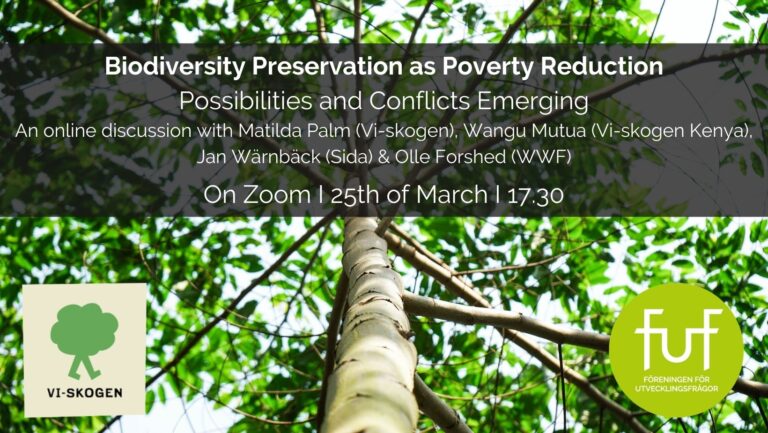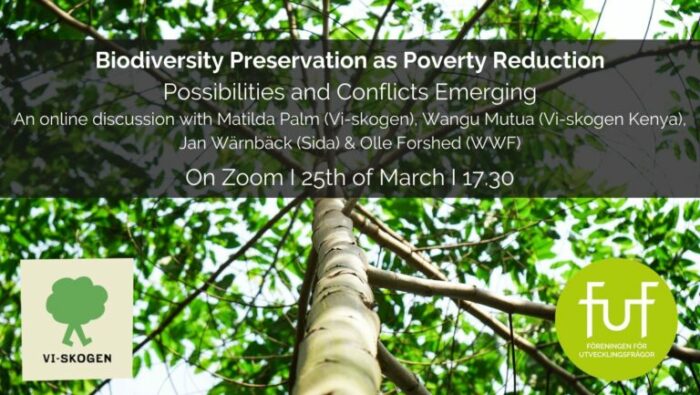Placing biodiversity and fighting poverty side by side
Date
March 31, 2021
 Biodiversity is increasingly coming into focus in the global debate as well as in Swedish foreign aid. Jan Wärnbäck, Policy Specialist at Sida, gave insights into this trend at the webinar. From Vi Agroforestry, Dr Matilda Palm and Deputy Regional Director Wangu Mutua, gave examples of how biodiversity and poverty alleviation can and should indeed go hand in hand. Dr Olle Forshed, Expert on rainforest and tropical forestry at WWF helped put the biodiversity debate into context:
Biodiversity is increasingly coming into focus in the global debate as well as in Swedish foreign aid. Jan Wärnbäck, Policy Specialist at Sida, gave insights into this trend at the webinar. From Vi Agroforestry, Dr Matilda Palm and Deputy Regional Director Wangu Mutua, gave examples of how biodiversity and poverty alleviation can and should indeed go hand in hand. Dr Olle Forshed, Expert on rainforest and tropical forestry at WWF helped put the biodiversity debate into context:
“In my lifetime, from the 1970s onwards, we have seen a 68 percent decline in biodiversity,” Dr Forshed pointed out. “It’s very hard to take in.” There are five main reasons for this sharp decline in biodiversity, where habitat loss is at the top. Humans have affected 75 percent of all land area today, Dr Forshed explained. Other reasons are overexploitation, such as overfishing and too intensive hunting of different species, invasive species, pollution and the now increasingly noticeable effects of climate change.
The importance of biodiversity to us humans is demonstrated, among other things, by the many ecosystem services we need – everything from insects pollinating flowers to trees that provide us with food and shelter, worms that keep the soil fertile, and much more.
“There is a vicious circle in which the degradation of ecosystems exacerbates poverty. And the more poverty, the more degradation of ecosystems. The impact of ecosystem degradation is also most severely felt by people living in poverty, said Dr Palm, Advisor on environmental and climate at Vi Agroforestry.
But simply allocating large areas to preserving nature and its biodiversity is not an optimal solution, as it can prevent people in a situation of poverty from making a living, Dr Palm underlined. She further pointed out that:
“It is important to balance biodiversity and poverty alleviation. We must work towards solutions where ecological integrity is maintained but where people are not harmed because they are unable to meet their basic needs.”
Methods such as agroforestry can be one such solution where both humans and nature win. This is absolutely crucial in areas such as the countryside around Lake Victoria, where Vi Agroforestry works.
“They don’t have access to modern technology in their everyday lives. They need to grow the food they are going to eat, and they need to go to the river to fetch water for their family and animals,” said Wangu Mutua, deputy regional director of Vi Agroforestry in East Africa. She was referring to the target groups Vi Agroforestry is working with in the region, reminding everyone listening how dependent most people truly are on ecosystems and the biodiversity in nature.
In October last year, the Swedish government announced a commitment to step up their efforts to integrate poverty reduction with biodiversity preservation measures. Jan Wärnbäck, Policy Specialist on environmental and climate at Sida, gave a brief orientation to this new initiative. He explained how Sida will integrate biodiversity more clearly into the agency’s existing foreign aid programmes and work. There are also plans for taking onboard more projects and activities with a focus on biodiversity.
Towards the end of the webinar, there was a moderated discussion where the speakers answered questions from the audience. This discussion highlighted both challenges and opportunities with combining poverty reduction and biodiversity preservation. Ms Mutua took the opportunity to remind the audience that:
“You really need to listen to the indigenous peoples and communities. They know best what works well.” As an example, she underlined that local communities often know best what plants and trees grow well in an area, since they have seen what the area used to look like before deforestation or other human interventions.
The webinar in its entirety was recorded by the Swedish Development Forum and can be viewed at https://youtu.be/Q2BHRpm4_2g
Text by Joakim Rådström, translated and adapted by Åsa Ljusenius